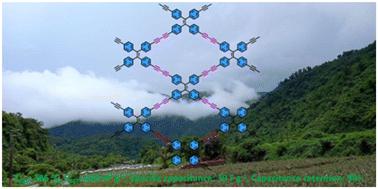当前位置:
X-MOL 学术
›
Polym. Chem.
›
论文详情
Our official English website, www.x-mol.net, welcomes your
feedback! (Note: you will need to create a separate account there.)
Construction of fully π-conjugated, diyne-linked conjugated microporous polymers based on tetraphenylethene and dibenzo[g,p]chrysene units for energy storage
Polymer Chemistry ( IF 4.1 ) Pub Date : 2024-06-18 , DOI: 10.1039/d4py00421c Mohamed Gamal Mohamed , Santosh U. Sharma , Pei-Tzu Wang , Mervat Ibrahim , Meng-Hao Lin , Cheng-Liang Liu , Mohsin Ejaz , Hung-Ju Yen , Shiao-Wei Kuo
Polymer Chemistry ( IF 4.1 ) Pub Date : 2024-06-18 , DOI: 10.1039/d4py00421c Mohamed Gamal Mohamed , Santosh U. Sharma , Pei-Tzu Wang , Mervat Ibrahim , Meng-Hao Lin , Cheng-Liang Liu , Mohsin Ejaz , Hung-Ju Yen , Shiao-Wei Kuo

|
In recent years, the quest for efficient and durable electrode materials for supercapacitors has driven the development of novel conjugated microporous polymers (CMPs). This study presents the synthesis and comprehensive characterization of two novel π-conjugated diyne-linked CMPs, TPE-Diyne CMP and TBN-Diyne CMP, designed as electrode materials for supercapacitors. These Diyne-CMPs were synthesized via a palladium-catalyzed alkyne–alkyne coupling reaction in high yields. Spectroscopic analyses, including FTIR and NMR, confirmed the distinct chemical structures of TPE-Diyne and TBN-Diyne CMPs, highlighting the presence of aromatic and alkyne groups essential for their electrochemical properties. Thermogravimetric analysis (TGA) demonstrated their remarkable thermal stability up to 800 °C under N2. Furthermore, nitrogen adsorption–desorption measurements revealed high specific surface areas of 428 m2 g−1 for the TPE-Diyne CMP and 256 m2 g−1 for the TBN-Diyne CMP, with well-defined microporosity. Electrochemical performance tests showed that the TPE-Diyne CMP achieved a specific capacitance of 39 F g−1, a capacitance retention of 98% after 2000 charge-discharge cycles and an energy density of 3.82 Wh kg−1, indicating exceptional stability and energy storage capability. Meanwhile, the TBN-Diyne CMP exhibited a specific capacitance of 32.4 F g−1, a cycling stability of 92% and an energy density of 3 Wh kg−1. These results underscore the significance of TPE-Diyne and TBN-Diyne CMPs as innovative and highly effective electrode materials for next-generation supercapacitors, offering enhanced performance and stability. The findings contribute valuable insights into developing advanced materials for energy storage applications, addressing the growing demand for high-performance supercapacitors in various technological fields.
中文翻译:

基于四苯乙烯和二苯并[g,p]屈单元构建用于储能的全π共轭、二炔连接的共轭微孔聚合物
近年来,对超级电容器高效耐用电极材料的追求推动了新型共轭微孔聚合物(CMP)的发展。本研究介绍了两种新型 π 共轭二炔连接 CMP(TPE-Diyne CMP 和 TBN-Diyne CMP)的合成和综合表征,它们被设计为超级电容器的电极材料。这些二炔-CMP 通过钯催化的炔烃偶联反应以高产率合成。包括 FTIR 和 NMR 在内的光谱分析证实了 TPE-Diyne 和 TBN-Diyne CMP 的独特化学结构,强调了对其电化学性能至关重要的芳香族和炔基的存在。热重分析 (TGA) 证明了它们在 N 2 下高达 800 °C 的出色热稳定性。此外,氮气吸附-解吸测量显示 TPE-Diyne CMP 的高比表面积为 428 m 2 g −1 和 256 m 2 g −1 用于 TBN-Diyne CMP,具有明确的微孔性。电化学性能测试表明,TPE-Diyne CMP的比电容为39 F g − 1 ,2000次充放电循环后电容保持率为98%,能量密度为3.82 Wh kg −1 ,具有出色的稳定性和储能能力。同时,TBN-Diyne CMP的比电容为32.4 F g − 1 ,循环稳定性为92%,能量密度为3 Wh kg −1 .这些结果强调了 TPE-Diyne 和 TBN-Diyne CMP 作为下一代超级电容器创新且高效的电极材料的重要性,可提供增强的性能和稳定性。 这些发现为开发用于储能应用的先进材料提供了宝贵的见解,满足了各个技术领域对高性能超级电容器不断增长的需求。
更新日期:2024-06-18
中文翻译:

基于四苯乙烯和二苯并[g,p]屈单元构建用于储能的全π共轭、二炔连接的共轭微孔聚合物
近年来,对超级电容器高效耐用电极材料的追求推动了新型共轭微孔聚合物(CMP)的发展。本研究介绍了两种新型 π 共轭二炔连接 CMP(TPE-Diyne CMP 和 TBN-Diyne CMP)的合成和综合表征,它们被设计为超级电容器的电极材料。这些二炔-CMP 通过钯催化的炔烃偶联反应以高产率合成。包括 FTIR 和 NMR 在内的光谱分析证实了 TPE-Diyne 和 TBN-Diyne CMP 的独特化学结构,强调了对其电化学性能至关重要的芳香族和炔基的存在。热重分析 (TGA) 证明了它们在 N 2 下高达 800 °C 的出色热稳定性。此外,氮气吸附-解吸测量显示 TPE-Diyne CMP 的高比表面积为 428 m 2 g −1 和 256 m 2 g −1 用于 TBN-Diyne CMP,具有明确的微孔性。电化学性能测试表明,TPE-Diyne CMP的比电容为39 F g − 1 ,2000次充放电循环后电容保持率为98%,能量密度为3.82 Wh kg −1 ,具有出色的稳定性和储能能力。同时,TBN-Diyne CMP的比电容为32.4 F g − 1 ,循环稳定性为92%,能量密度为3 Wh kg −1 .这些结果强调了 TPE-Diyne 和 TBN-Diyne CMP 作为下一代超级电容器创新且高效的电极材料的重要性,可提供增强的性能和稳定性。 这些发现为开发用于储能应用的先进材料提供了宝贵的见解,满足了各个技术领域对高性能超级电容器不断增长的需求。











































 京公网安备 11010802027423号
京公网安备 11010802027423号